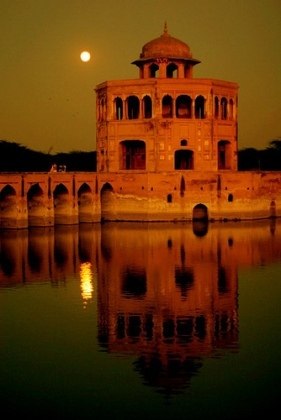 Those who take their chance to cross the River Ravi from Saghian Bridge to go to Sheikhupura in the suburbs of Lahore have to pass through the flower nurseries. Also, along the road has come up a Flower Market near Saghian Bridge. After turning on Sheikhupura-Sargodha Road from the Chowk where a beautiful replica of Hiran Minar (The Deer Tower) has been made, you drive along the bumpy two-way road lined up on both sides with smoke emitting factories of different kinds: fabrics, chemicals, glass, and paper pulp. At places the pungent whiff reminds as if one is driving on Grand Trunk Road near Kala Shah Kaku. Wall chalking, religious and or commercial slogans – is another thing that one notices all along the road to Sheikhupura.
Those who take their chance to cross the River Ravi from Saghian Bridge to go to Sheikhupura in the suburbs of Lahore have to pass through the flower nurseries. Also, along the road has come up a Flower Market near Saghian Bridge. After turning on Sheikhupura-Sargodha Road from the Chowk where a beautiful replica of Hiran Minar (The Deer Tower) has been made, you drive along the bumpy two-way road lined up on both sides with smoke emitting factories of different kinds: fabrics, chemicals, glass, and paper pulp. At places the pungent whiff reminds as if one is driving on Grand Trunk Road near Kala Shah Kaku. Wall chalking, religious and or commercial slogans – is another thing that one notices all along the road to Sheikhupura.
Jehangir Abad turned Sheikhupura is situated in Ravi-Chenab corridor and fast turning from a market agricultural town to an industrial city. Adjacent to Lahore, the town is surrounded by old places like Sangla Hill (old Sakala), Nankana Saheb (birth place of Baba Guru Nanak) and Jandiala Sher Khan (last resting place of Waris Shah).
Hunting grounds were an important part of the physical environment of Moghal emperors. The place where the town stands today was one of Jahangir’s (Prince Salim) princely dominions during his father Akbar’s reign. The town was founded by Jehangir, near village Sahu Malli, during his rule in 1607. The king declared the barren jungles adjoining the place as royal hunting ground. After the death of king’s darling deer Mans Raj, this hunting ground was changed into a protected sanctuary and hunting was prohibited. In the memory of his favourite antelope, the king also constructed an octagonal tower in 1607 at the foot of the grave of the deer. In 1620, a square lake like pond and Baradari was added to the monument. A causeway with its own gateway connects the pavilion with the mainland and minaret. At the centre of each side of the tank, a brick ramp slopes down to the water that used to provide access for royal animals and wild game. Later he conferred the entire area upon Sikandar Moin.
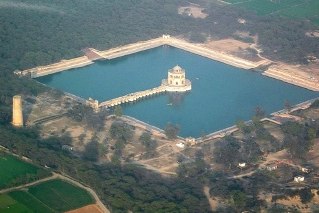 A special feature of Hiran Minar is its location and environment: the top of the Minar is perhaps the best place in the province of Punjab to get a feel for the broader landscape and its relationship to a Moghal site. Looking north from the top of the Minar, one can see a patch of forest which is similar to the scrub forest vegetation of Moghal times, while to the west are extensively-irrigated fields, a product of the late nineteenth and early twentieth centuries, but similar in size and appearance to the well-irrigated fields of the Moghal period. The Lower Chenab Canal has turned the land into one of the most fertile area in the country now.
A special feature of Hiran Minar is its location and environment: the top of the Minar is perhaps the best place in the province of Punjab to get a feel for the broader landscape and its relationship to a Moghal site. Looking north from the top of the Minar, one can see a patch of forest which is similar to the scrub forest vegetation of Moghal times, while to the west are extensively-irrigated fields, a product of the late nineteenth and early twentieth centuries, but similar in size and appearance to the well-irrigated fields of the Moghal period. The Lower Chenab Canal has turned the land into one of the most fertile area in the country now.
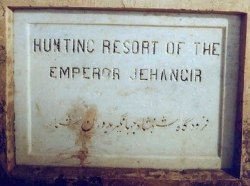 In eighteenth century, Nadir shah and Ahmed shah Abdali passed through Jehangir Abad once they came to attack India. Punjabi poet Syed Waris Shah had composed some pointing details of the attacks and conditions of the society of the time in his classic folk romance Heer Ranjha. Sikh came to the power in the later half of eighteenth century when Moghal authority weakened after the death of Aurangzeb Alamgir. It is during Sikh rule that the name of the town was changed from Jehangir Abad to Sheikhupura.
In eighteenth century, Nadir shah and Ahmed shah Abdali passed through Jehangir Abad once they came to attack India. Punjabi poet Syed Waris Shah had composed some pointing details of the attacks and conditions of the society of the time in his classic folk romance Heer Ranjha. Sikh came to the power in the later half of eighteenth century when Moghal authority weakened after the death of Aurangzeb Alamgir. It is during Sikh rule that the name of the town was changed from Jehangir Abad to Sheikhupura.
Sheikhupura was separated from Gujranwala and declared district in 1920 with Sharq Pur and Khankah Dogran as two of its tehsiels. Electricity came into the town in 1931. During independence movement, Quaid-e-Azam Mohammad Ali Jinnah addressed a huge crowd in Sheikhupura while going to Faisalabad (then Layal Pur) in 1942. Later, the geographical boundaries of the district were again changed in 1962. The remains of once majestic Sheikhupura Fort, constructed by King Jehangir, reminds of the times gone by. Five storied building of the Fort speak of the expertise of its architects. The Moghul Fort was built in 1619 for use as a hunting lodge. The Fort is built of bricks rather than stone, a common feature of Moghul forts. The Fort was later used by Sikh Princess Rani Nakayan and her private quarters are decorated with superbly preserved frescoes depicting dancing girls, hunt and court scenes and images of Guru Nanak. History has it that Arbeel Singh fired one hundred rounds on the Sheikhupura Fort to break in. During Ranjeet Singh’s time, the Fort was renovated. Some of the murals are still there on the walls of the Fort. Around the Fort, some wood carving on doors, windows and balconies of old havelies can be seen being eaten by termite.
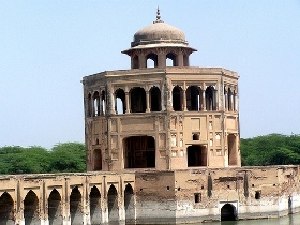 Maharani Jind Kaur (some time called Rani Jindaan), who was described by Lord Dalhousie as the only woman in the Punjab with manly understanding and in whom the British Resident foresaw a rallying point for the well-wishers of the Sikh dynasty, was kept under close surveillance in Sheikhupura Fort. Henry Lawrence laid down that she could not receive in audience more than five or six sardars in a month and that she remain in purdah like the ladies of the royal families of Nepal, Jodhpur and Jaipur. Maharani Jind Kaur was later exiled from the Punjab. She was taken to Firozpur and then to Banaras. Her annual allowance, which according to the treaty of Bharoval had been fixed at one and a half lakh of rupees, was reduced to twelve thousand. Her jewellery worth fifty thousand of rupees was forfeited; so was her cash amounting to a lakh and a half. The humiliating treatment of the Maharani caused deep resentment among the people of the Punjab. Even the Muslim ruler of Afghanistan, Amir Dost Muhammad, protested to the British, saying that such treatment is objectionable to all creeds.”
Maharani Jind Kaur (some time called Rani Jindaan), who was described by Lord Dalhousie as the only woman in the Punjab with manly understanding and in whom the British Resident foresaw a rallying point for the well-wishers of the Sikh dynasty, was kept under close surveillance in Sheikhupura Fort. Henry Lawrence laid down that she could not receive in audience more than five or six sardars in a month and that she remain in purdah like the ladies of the royal families of Nepal, Jodhpur and Jaipur. Maharani Jind Kaur was later exiled from the Punjab. She was taken to Firozpur and then to Banaras. Her annual allowance, which according to the treaty of Bharoval had been fixed at one and a half lakh of rupees, was reduced to twelve thousand. Her jewellery worth fifty thousand of rupees was forfeited; so was her cash amounting to a lakh and a half. The humiliating treatment of the Maharani caused deep resentment among the people of the Punjab. Even the Muslim ruler of Afghanistan, Amir Dost Muhammad, protested to the British, saying that such treatment is objectionable to all creeds.”
Old Rai Pur and now famous Nanakana Sahib, a birth place of Guru Nanak and last resting place of Waris Shah in Jandiala Shekhan are also claims of Sheikhupura to international fame. Gazetteer of the district written by British reads, Nanakana Sahib was then in the heart of jungle thirty miles from the nearest railway station and on the anniversary of the Guru’s birth was visited by a few hundred pious pilgrims. These days much more Sikhs from all over the world visit the birth place of Baba Nanak.
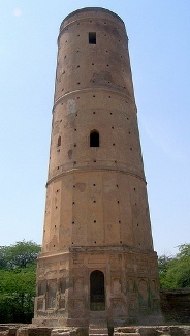 Despite being near Lahore, the town has not developed and all the civic facilities are over burdened. Over crowding, population increase, litter, and power outages have all played a part in turning small hamlet into a teeming sprawling slum. Moghal King who founded it would not be able to recognize the town if he comes back. There are no sufficient healthy recreations in town and people of Sheikhupura go to Lahore to have an eating experience at Food Street, for celebrating basant bash or for other recreations. The main road that passes through the town was once landscaped on both sides. Now the landscape and green strips along the road have vanished. The bifurcation railing in the middle of the road has broken down at places and people have made crossing points there. Completion of Jinnah Park was very festive for the residents of Sheikhupura but now it gives a repulsive look rather than that of a recreational place. On entering the gate one realizes that the park is not being maintained. Result: polythene bags and wrappers are scattered every where, the grass has not been mowed, there are no flowers, and benches are broken and dusty. A rehriwalla who sells ‘Dahi Bhallay’ in front of the park says, “I used to do much better business when the park was newly completed but now no body comes here.”
Despite being near Lahore, the town has not developed and all the civic facilities are over burdened. Over crowding, population increase, litter, and power outages have all played a part in turning small hamlet into a teeming sprawling slum. Moghal King who founded it would not be able to recognize the town if he comes back. There are no sufficient healthy recreations in town and people of Sheikhupura go to Lahore to have an eating experience at Food Street, for celebrating basant bash or for other recreations. The main road that passes through the town was once landscaped on both sides. Now the landscape and green strips along the road have vanished. The bifurcation railing in the middle of the road has broken down at places and people have made crossing points there. Completion of Jinnah Park was very festive for the residents of Sheikhupura but now it gives a repulsive look rather than that of a recreational place. On entering the gate one realizes that the park is not being maintained. Result: polythene bags and wrappers are scattered every where, the grass has not been mowed, there are no flowers, and benches are broken and dusty. A rehriwalla who sells ‘Dahi Bhallay’ in front of the park says, “I used to do much better business when the park was newly completed but now no body comes here.”
The main attraction of the town is a Hiran Minar Complex. Aside from common visitors, foreign dignitaries, guests of the federal or the provincial governments, who visit Lahore, are sometimes taken to Hiran Minar in Sheikhupura for a short break. It is also on the schedules of some tourist operators. But the monument is not being maintained properly and local population is not benefiting from it. Given proper care, it could be turned into a real restful facility for locals as well as foreigners.
What Sheikhupura really needs is: an identity, completion and commissioning of bypass, some grass in Jinnah Park and along the road and development of Hiran Minar.
Photo Credits: Flickr.com here, here, here and here.
This post was first published on Shirazi’s blog.


















































hello guys….. i’m hunny verma from india.. this is my grandfather’s birthplace.. and he is exactly from feroz watwan-sheikhupura.. i wanna know about that place.. is any body here who is from feroz watwan?????????? or atleast who can share the pictures of feroz watwan????? i’ll be very thankful to him… if any generous buddy can help me than add me on facebook my id is
vhunny@ymail.com
thank you.. :))
We are planning to visit Hiran Minar. Can someone tell if the pond is still full of water as in the pictures? What attractions are there if we drive from Lahore?
Thanks.
Great article and well written! I Have visited Pakistan many times, and artciles such as this makes one want to go again. As a Sikh in the UK, I feel the true Punjab is in Pakistan and it is traditionally preserved!
Just a trivia. The famous Shahi Mahalla of Lahore is also known as Mahalla Shekhupurian! Of course Shekhu was a nickname of Prince Salim who along with his courtiers regularly patronized the courtesans of Shahi Mahalla.
I don’t think it was the Sikhs who changed the name from Jehangirabad to Sheikhupura – it was always known as Sheikhupura. The Emperor Akbar’s nickname for his son Salim was ‘Sheikhu’ (after Sheikh Salim Chishti, who has forecast the birth of Salim).